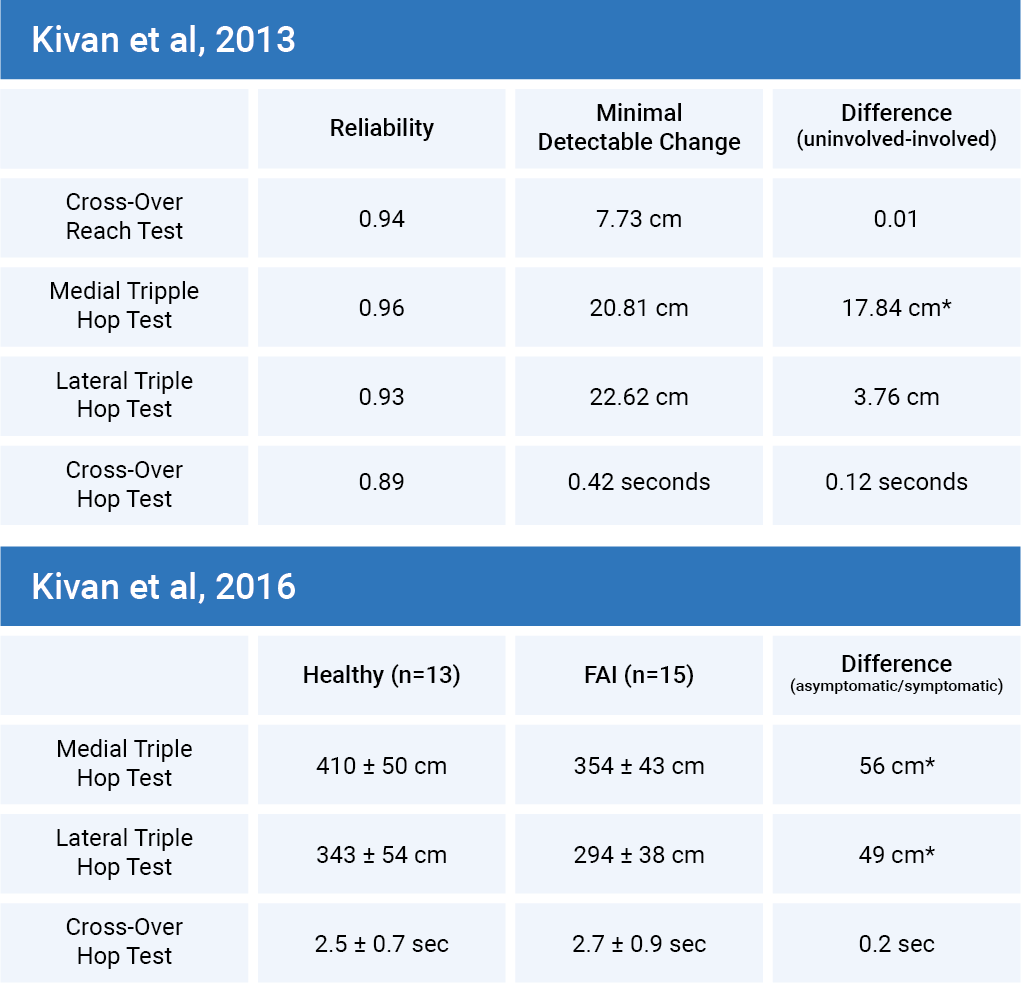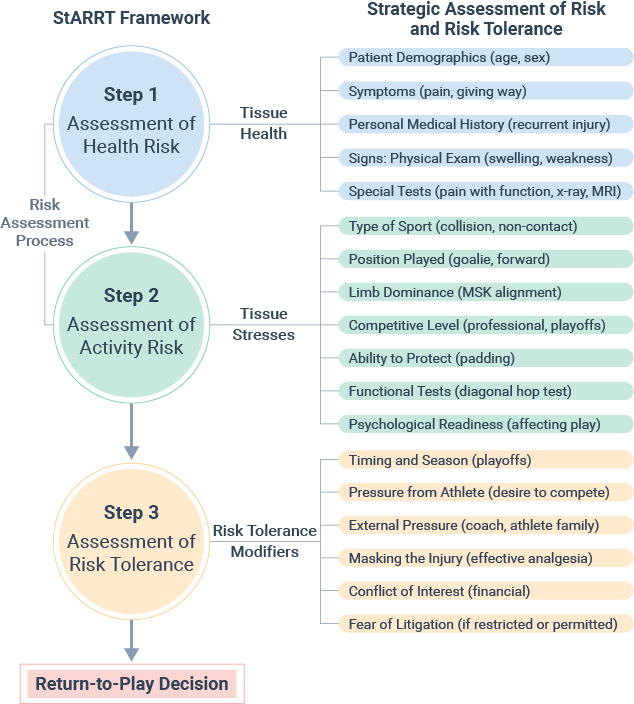Hip Pain: Return to Sport Considerations

Pre-arthritic hip pain is a common occurrence among athletes, especially those competing in ice hockey1 and field-based team sports (soccer, rugby, and football).2 While this area receives less attention than knee or shoulder injuries, current research is beginning to improve diagnosis and treatment of both intra-articular and extra-articular hip pathology. But, what about return to sport?
What the Literature Says
Determining an athlete’s readiness to return to sport is complicated. The decision with regards to hip pathology is even more convoluted due to the lack of evidence. Most literature discusses outcomes following arthroscopic surgery, and only a few studies outline the proposed benefit of conservative management.3
The available literature suggests that surgery for femoroacetabular impingement is beneficial in a symptomatic population, with 87% of patients returning to sport and 82% returning to previous level of competition.4 On the other hand, no randomized controlled studies adequately compare conservative and surgical management.5 Unfortunately, at this point the research tends to relate only to reported patient satisfaction, subjective questionnaires, and self-reported return to sport.6
How Do We Determine Return to Sport?
Unlike ACL reconstruction, hip injury lacks sufficient evidence to support return to sport guidelines. According to the 2016 Consensus Statement on Return to Sport, clinicians should combine information from a biological, psychological, and social standpoint.7 These factors include:
- Health risk based on the athlete’s specific injury (subjective and objective measures)
- Activity risk of returning to sport (type of sport, competition level, etc.)
- Risk tolerance (pressure, fear of re-injury, etc.)
The StAART Framework (pictured below) proposed by Shrier and colleagues sums up this approach.8 It allows the clinician to comprehend and address all areas impacted by an individual’s readiness to return to sport.
Functional Testing Considerations
A recent systematic review conducted by Kivlan and colleagues demonstrated that several tests are reliable and valid when determining return to sport after hip injuries:9
- Single-leg Stance
- Deep Squat
- Single-leg Squat
- Star Excursion Balance Test / Y-Balance Test
These tests have appropriate validity and reliability but no solid cut-points, so findings should be interpreted on a patient-specific basis by considering their limb symmetry index during these tasks. Significant increase in medial–lateral sway and worse anterior–posterior control during a dynamic single-leg squat task in individuals with pre-arthric hip pain supports the use of a single-leg squat assessment.10
Several recent studies have investigated if hop testing is appropriate in this population. Kivlan and colleagues evaluated the difference in hop testing (cross-over reach test, medial triple hop test, lateral triple hop test, and cross-over hop test) between the involved and uninvolved hip in dancers with hip pathology.11 All tests demonstrated excellent reliability (0.89 – 0.96); however, only the medial triple hop test showed significant difference between the two limbs with the non-involved limb achieving 17.8 cm more distance than the involved limb.
More recently, Kivlan and colleagues investigated the hop performance between dancers with clinically diagnosed femoroacetabular impingement and an asymptomatic control group. This study found a significant difference of approximately 50 cm when comparing the performance of the FAI group to the asymptomatic control group during both the medial triple hop test and the lateral triple hop test:12

Further supporting the use of hop and dynamic balance activities, findings from another recent study determined that following arthroscopic hip surgery and concomitant rehabilitation, patients demonstrated > 90% limb symmetry index in the performance of a single-leg squat test, single-leg vertical jump, single-leg hop for distance, and single-leg side hop.13 While this information shows that we can achieve a LSI that is often used in return to sport of athletes post-ACL reconstruction, functional testing should be used with caution when translating it to a population of athletes with hip pain.
Continue with Caution
In the absence of definitive return to sport criteria, the clinician must focus on the tissue health (the load the tissue can absorb before injury), individual tissue stresses imposed by the athlete’s chosen sport and competition level, and any pertinent psychosocial factors (fear of re-injury).
Return to sport testing should be considered with caution as little evidence is available for this patient population.
- Lerebours F, Robertson W, Neri B, Schulz B, Youm T, Limpisvasti O. Prevalence of Cam-Type Morphology in Elite Ice Hockey Players. Am J Sports Med. 2016 Jan 28. pii: 0363546515624671. [Epub ahead of print]
- Gerhardt MB, Romero AA, Silvers HJ, Harris DJ, Watanabe D, Mandelbaum BR. The Prevalence of Radiographic Hip Abnormalities in Elite Soccer Players. American Journal of Sports Medicine. 2012;40(3):584-588. doi:10.1177/0363546511432711.
- Wall PD, Fernandez M, Griffin D, Foster N. Nonoperative Treatment for Femoroacetabular Impingement: A Systematic Review of the Literature. PMRJ. March 2013:1-9. doi:10.1016/j.pmrj.2013.02.005.
- Casartelli NC, Leunig M, Maffiuletti NA, Bizzini M. Return to sport after hip surgery for femoroacetabular impingement: a systematic review. British Journal of Sports Medicine. 2015;49(12):819-824. doi:10.1136/bjsports-2014-094414.
- Reiman MP, Thorborg K, Hölmich P. Femoroacetabular Impingement Surgery Is on the Rise—But What Is the Next Step? Journal of Orthopaedic & Sports Physical Therapy. 2016;46(6):406-408. doi:10.2519/jospt.2016.0605.
- Sim Y, Horner NS, de SA D, Simunovic N, Karlsson J, Ayeni OR. Reporting of non-hip score outcomes following femoroacetabular impingement surgery: a systematic review. J Hip Preserv Surg. 2015;2(3):224-241. doi:10.1093/jhps/hnv048.
- Ardern CL, Glasgow P, Schneiders A, et al. 2016 Consensus statement on return to sport from the First World Congress in Sports Physical Therapy, Bern. British Journal of Sports Medicine. May 2016. doi:10.1136/bjsports-2016-096278.
- Shrier I. Strategic Assessment of Risk and Risk Tolerance (StARRT) framework for return-to-play decision-making. Br J Sports Med 2015;49:1311–15.
- Kivlan BR, Martin RL. FUNCTIONAL PERFORMANCE TESTING OF THE HIP IN ATHLETES: A SYSTEMATIC REVIEW FOR RELIABILITY AND VALIDITY. International Journal of Sports Physical Therapy. 2012;7(4):402-412.
- Freke MD, Kemp J, svege I, Risberg MA, Semciw A, Crossley KM. Physical impairments in symptomatic femoroacetabular impingement: a systematic review of the evidence. British Journal of Sports Medicine. June 2016. doi:10.1136/bjsports-2016-096152.
- Kivlan BR, Carcia CR, Clemente FR, Phelps AL, Martin RL. Reliability and validity of functional performance tests in dancers with hip dysfunction. Int J Sports Phys Ther. 2013 Aug;8(4):360-9.
- Kivlan BR, Carcia CR, Christoforetti JJ, Martin RL. Comparison of Range of Motion, Strength, and Hop Test Performance of Dancers with and without a Clinical Diagnosis of Femoroacetabular Impingement. International Journal of Sports Physical Therapy. 2016; 11(4): 527-535.
- Tijssen M, van Cingel R, de Visser E, Sanden der MN-V. A clinical observational study on patient-reported outcomes, hip functional performance and return to sports activities in hip arthroscopy patients. Physical Therapy in Sport. 2016;20(C):45-55. doi:10.1016/j.ptsp.2015.12.004.










